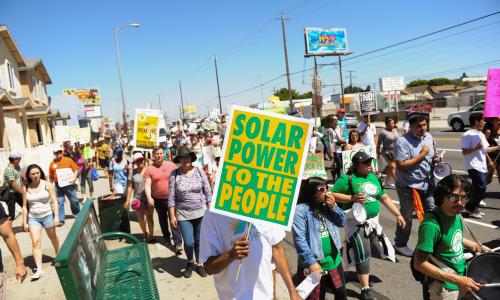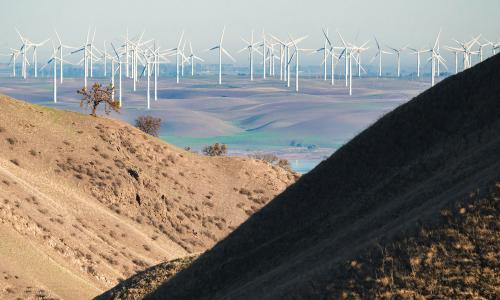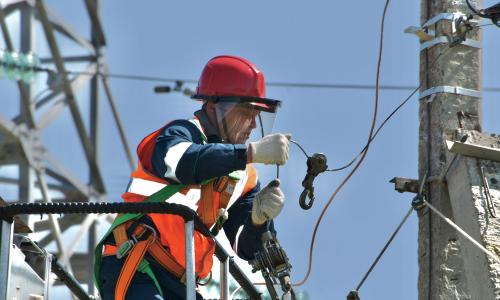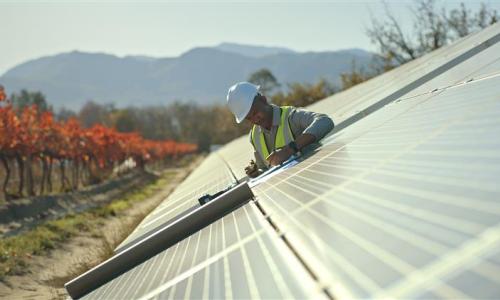Table of Contents
Access to clean, safe, reliable electricity shouldn’t be determined by the amount of money in your bank account or by where you live. This toolkit can help.
We asked hundreds of people about their experiences, negative and positive, with electric utility services. Their responses reflect massive inequalities in access, affordability, and dozens of other issues with today’s power grid.
It doesn’t have to be this way. Armed with personal experience and a deep understanding of how the grid works—and why it came to be this way—everyday people can become powerful advocates for a safer, better power system.
This electric utility toolkit can help. Below, you’ll find specific information about your state, and explanatory materials that de-mystify the power sector’s jargon. At the end of the page we’ve assembled a robust list of actions and next steps, each geared at building a more just and inclusive electric utility system.
Step 1: Know your state
So, you're ready to start engaging with your decision makers. Where do you start? The answer is... it depends. Use our tool below to look up your state.
Step 2: Know your history
Although the electric grid is a collection of inanimate objects such as wires and metal, our energy system—which includes all the tangible and intangible parts related to the production, conversion, delivery, and use of energy—inherently captures the discriminatory beliefs of those who designed it, creating conditions that are harmful to communities across generations.
An abundance of data shows that our energy system has had a disproportionately negative impact on the health and well-being of Black, Indigenous, People of Color (BIPOC), and low-income communities. The siting of energy infrastructure has resulted in disproportionate impacts, such as polluted water and air, which have, in turn, led to increased health problems for these groups. Compounding these experiences are energy injustices, including:
High energy burden
A household's "energy burden" refers to the percentage of income spent on home energy bills. Energy burdens are considered high when a household must spend more than six percent of its income on energy and severely high when the percentage exceeds 10 percent. Research shows that, in the United States, low-income households, renters, Black, Hispanic, Native American, and older adult households all have disproportionately higher energy burdens. These groups' energy burden averages 8 percent—almost three times higher than that of non-low-income households, according to the US Department of Energy (DOE).
Energy insecurity
Energy insecurity occurs when households—often with high energy burdens—struggle to meet basic needs. According to the Boston University Institute for Global Sustainability, "The impacts of energy insecurity fall along many of the same fault lines of overall social equity: income, race, ethnicity, and the type and tenure of housing." In 2023, the US DOE reported nearly 26 percent of all US households experienced energy insecurity "almost every month, some months, or 1 to 2 months within the last year."
Energy inequity
A core principle of "energy equity" addresses unequal access to energy resources, a comparative construct relative to their circumstances that often leads disadvantaged groups to suffer more than others. It is important to note that multiple inequalities can exist within the energy system, such as:
- Inequitable access to clean-energy benefits: Energy access inequities arise when the economic benefits of clean-energy programs fail to reach the customers who need them the most. For example, Black-majority census tracts installed 69 percent fewer rooftop photovoltaic panels than non-black-majority tracts of the same median household income. According to a 2022 report from the DOE's Office of Indian Energy, nearly 17,000 tribal homes were without electricity, highlighting another aspect of inequitable access to energy.
- Inequitable reliability of energy services: Climate change is causing an increase in extreme weather events, leading to increased power outages. These outages are also lasting longer due to an aging electric grid. According to a recent study, highly vulnerable populations are more likely to experience frequent and prolonged power outages. The study identified vulnerability factors, including socioeconomic status, household composition and disability, minority status and language, housing type, and transportation. Additionally, data from the US Energy Information Administration shows that, between 2013 and 2021, the average duration of power outages in the United States doubled from approximately 3.5 hours to more than seven hours.
- Inequitable cumulative impacts: According to the US Environmental Protection Agency (EPA), cumulative impacts refer to the overall effects that arise from exposure to a combination of chemical and non-chemical stressors on health, well-being, and quality of life. These sources of environmental pollution are not uniformly distributed and do not occur in isolation. As a result, communities experience compounded economic, social, and environmental challenges. The costs of these inequities are disproportionately borne by communities, resulting in lost work days, school absenteeism, and higher healthcare, among other circumstances.
Environmental racism has a significant impact on our communities. As a recent article put it: "Where we live determines opportunities to access high-quality education, employment, housing, fresh foods or outdoor space—all contributors to our health." Proximity to polluting power plants plays a role, for example, because it contributes to peoples' exposure to concentrations of fine particulate matter (PM 2.5) and other harmful air emissions. A recent study found that exposures to PM 2.5 are higher for residents of lower-income communities; the study also found that the disparities are larger by race than by income. In 2016, the average PM2.5 concentration for the Black population was found to be 13.7 percent higher than that of the white population. Furthermore, as of 2020, across America, nearly 40 percent of Black children live in areas with poor environmental and health conditions compared to just 10 percent of White children.
The siting of fossil fuel plants reflects a history of discriminatory housing and environmental policies, a legacy known as redlining, a practice, now illegal, that outlined areas where Black residents lived and deemed them as risky investments. One 2023 article studied historical redlining in association with fossil fuel power plant siting, correlating that neighborhoods regarded as D grade, or "redlined," faced a higher likelihood of having a power plant sited, bringing with it higher emissions of air pollutants such as nitrogen oxides, sulfur dioxide, and fine particulate matter.
Addressing these enduring inequalities requires us to work to change society at many levels—including our energy system. Democratizing the energy system by implementing energy justice principles is a critical shift toward acknowledging energy as a fundamental human right. This shift will help empower communities to participate actively, more justly, and equitably in decisions about our energy sources, the infrastructure required to support them, and their associated costs.
While municipalities and cooperatives work to increase public participation, we must also focus on improving our nation's democratic processes to ensure that all voices are heard and represented. This will help us build a more sustainable and equitable energy system for everyone. The following are some principles of energy justice that can help us achieve the transformative change we need:
Distributive justice
Considers income, energy prices, and energy efficiency opportunities while also evaluating the distribution of the benefits of the clean energy transition. This principle also recognizes the disproportionate risk to populations in close proximity to polluting and harmful energy industries.
Procedural justice
Considers whether people and communities have access to information and a voice in decision-making regarding the development and operation of energy projects.
Restorative justice
Seeks to repair past harms to people and the environment and calls for identifying and implementing systemic solutions to address the causes.
It can be said that our present moment is a culmination of the decisions made in the past. Said another way, in the words of James Baldwin, "We are our history." As we grapple with the climate crisis and strive toward a decarbonized energy system, our present moment offers the chance to examine an ongoing transformation of every level of the energy system to revolutionize our way of operating to be reflective and considerate of all. The story doesn't end here: it begins with us.
None of us can be held responsible for the wrongs of our ancestors. But if today we choose not to do the right and necessary thing, that burden we own.
The US electricity grid
The electricity grid is working every second of every day to provide us with the electricity needed to power our modern lives.
The electricity grid is an immense network of power lines and technologies working together to carry electricity from sites where it's generated—such as power plants and wind farms—to sites where it is used—such as homes, schools, hospitals, and industry. Power created from various energy sources is delivered to homes, businesses, and other end users at the exact time it's needed. Power plants, power lines, and other infrastructure are the visible components of the grid, but its vital functions also depend on the effective coordination of a web of systems, institutions, rules, and people. Together, these factors play a major role in our lives each day, from when our alarm clocks go off to when we're making breakfast or picking up groceries. We rely on on-demand power at any time of day—something we rarely notice unless there is a power outage.
The process
The generation of electricity begins by taking resources—such as coal, wind, or fossil gas—and converting them from their raw, natural state into electrons that can power the electric outlets in your office, home, or classroom. This conversion normally occurs at large-scale utility power plants such as a wind facility, nuclear reactor, or a fossil fuel or coal plant. The resulting electrons are delivered to consumers through a system of substations, transformers, and regional transmission and neighborhood distribution lines. Increasingly, electricity is also generated at smaller, more distributed generating facilities, such as rooftop solar panels or at community solar farms. When generating facilities are located far away from end users, transmission lines are needed to carry high volumes of high-voltage electricity over long distances, connected to distribution networks that, in turn, deliver electricity "on-demand" to the homes, schools, and workplaces they serve. (See this UCS explainer for more details).
Regulation
The US electricity grid is divided into three major transmission networks—the Eastern Interconnection; the Western Interconnection; and the Texas Interconnection. Within these three major transmission entities, there are intricate, linked networks of regional and local electricity grids.
Importantly, across the United States, regional transmission is regulated by seven "regional transmission organizations," or RTOs, that plan and operate the power grid. These RTOs manage electricity markets to make sure that enough supply is available throughout their region at all times. RTOs are accountable to their investor-owned member utilities, and to state governments. RTOs are overseen by the Federal Energy Regulatory Commission (FERC), an independent, bipartisan agency within the US DOE that regulates the sale and transmission of electricity across state lines. FERC has authority and influence over the RTOs to ensure they are cooperative and fair. FERC can help address and resolve issues among different market participants. Currently, there are no RTOs for the southeast, southwest, or northwest regions. In those parts of the country, investor-owned utility corporations handle grid management needs directly themselves.
While RTOs help regulate the nation's energy system, the actual electricity distribution network—the system of wires that deliver electricity to end users at homes, schools, and businesses, is regulated using a different method. These networks, which are run by large utilities, are regulated at the state level by commissions or boards, often called public utility commissions (PUC), or sometimes public service commissions (PSC).
What are Public Utility Commissions (PUCs)?
A public utility commission, or PUC, (in some states called a Public Service Commission, or PSC) oversees and regulates the public utilities in each state—utilities such as electric, gas, water and wastewater, and telecommunications. These independent regulatory commissions set the retail rates for electricity and provide state-level oversight, determining, for instance, whether new electricity generating plants, or sources, or other energy infrastructure proposed by utilities should be built; their job is to scrutinize how these utility business plans and decisions will affect customers in the state.
As noted above, PUCs have the important role of "setting appropriate electricity rates that utilities must abide by." And, generally, members of PUCs, known as commissioners, are responsible for ensuring that utilities provide "reasonable, adequate, and efficient service to customers at reasonable prices." The role of the state PUC or PSC in this system is to participate in decisionmaking process to review and approve transmission lines to move electricity within the regions, and to ensure that utilities are providing affordable and reliable power to their ratepayers.
Different states handle PUCs differently
PUCs have a direct impact on electricity ratepayers, helping to determine how affordable electricity is, how reliable electric service is, and also other factors such as local air quality and climate impacts. But there are differences from state to state. In the electricity sector, each state is classified as either "traditionally regulated" or "restructured."
Use the tool above to determine which category your state is.
In traditionally regulated states, utilities operate as monopolies, and the PUC regulates electric utility planning, what resources are used to generate electricity, and the resulting cost of services. PUCs in these states regulate electricity generation, transmission, and distribution to consumers, while additional legislation and policies usually govern the power industry's investments in infrastructure—sometimes known as the "integrated resource planning process," or IRP.
In restructured states (sometimes known as "deregulated" states), power plants and the electricity they generate are owned and operated in a competitive market, rather than as a monopoly. In these states, PUCs only regulate the distribution of electricity to consumers but generally do not regulate investment in new power plants.
All of these PUC responsibilities have a direct impact on ratepayers in terms of energy affordability, service reliability, air quality, and climate impacts.
How do PUCs make decisions?
PUCs are formed and given regulatory power through each state's laws or constitution. Accordingly, the ways in which PUCs function and make regulatory decisions varies from state to state. Normally, PUCs make decisions through regulatory dockets and rule-making processes, which are similar to judicial proceedings and include the opportunity for stakeholders (sometimes known as "intervenors") to file comments or give testimony. In some states, PUCs also have enforcement authority and can impose sanctions if their decisions or rules are not followed.
The importance of representation in commissions
PUCs are typically made up of three to eight commissioners who are either appointed by the governor or elected by the public to serve four- or six-year terms. Commissioners hold a significant amount of power over critical decisions that affect energy consumers, but historically have not been representative of populations that are most impacted by issues such as high energy burdens and electricity shut offs. A large majority of commissioners around the country are white (82 percent) and male (65 percent). Racial diversity is low; only 11 percent of commissioners are Black and 3 percent each are either Hispanic/Latino or Asian. Only two out of 197 commissioners identify as Native American/American Indian. This racial disparity is especially striking in Southern states with a high proportion of Black populations. Mississippi, for example, has never elected a Black commissioner, and Alabama and Georgia have never had a Black female commissioner. As a report by The Chisholm Legacy Project states, commissioners should be representative of the populations that are most affected by the decisions made by them. This representational governance is critical to make sure that the rules, plans, and solutions coming out of a PUC are well-informed by the people who will be most impacted by them.
Moreover, a large number of commissioners have previously served as lobbyists or have ties to the fossil fuel industry, a relationship that likely influences their decisions regarding the industry they are charged with regulating. In 2022, Alaska, Oklahoma, and Kansas all had commissioners who had previously worked for or owned petrochemical companies. Furthermore, 13 current commissioners are former lobbyists or lawyers now in positions to regulate the stakeholders with whom they previously worked.
For more information about PUCs, commissioners, and the impact of representational government, see Who Holds the Power: Demystifying and Democratizing Public Utilities Commissions by Jacqui Patterson and Charles Hua.
Utility companies need to be aware of the hardships that we face so they can create programs that are more accessible to low-income customers. You can't help me if you don't understand my struggles.
How do PUCs affect you?
Affordability
If you’re struggling to pay your electricity bill, you are not alone. Energy affordability is a major issue for many US households, often measured in terms of an “energy burden,” or the percentage of gross household income paid for electricity and heating fuel. An affordable energy burden is considered 6 percent or less of a household’s gross income but, according to the US Department of Energy, low-income households (which make up about 44 percent of all US households) pay an average of 8.6 percent, with households in some areas of the country having an energy burden of 30 percent. Many US households experience energy insecurity and face the risk of shut offs by their utility. In most states, utilities must submit any request for rate increases to the state commission for approval, which makes the importance of ratepayers sharing their experience with commissioners critical to set rates that reflect the public’s best interest and avoid predatory debt collection measures implemented by some utilities. Every person should have the right to affordable energy. Some commissions make it easier to voice your opinion than others; use the tool above to learn more about how electricity is regulated in your state.
Reliability
Reliable access to electricity is essential for households. Sudden, repeated, or prolonged outages can put people at risk of losing food and medicine, illness from heat or cold, and sometimes can cause them to lose access to life-saving medical devices such as oxygen concentrators. Every person should have the right to reliable energy service. One of the main functions of the state PUCs is to ensure that local utilities are providing reliable service to customers. In several states, utilities are required to file plans known as “Integrated Resource Plans,” or IRPs, that spell out how the utility plans to provide reliable and affordable power to their customers. States often require that these plans be reviewed by the state PUCs. In addition, the state PUCs can require the utilities to properly maintain and repair distribution lines. Most PUCs also provide a way for customers and organizations to submit public written comments and may also hold public hearings where people can voice their comments and concerns about the utility’s plans.
Safety and health
Energy is essential for our health. Electricity, for example, provides us with access to air conditioning on hot days and refrigeration to keep our food safe. Energy production can also have negative impacts on our community’s health, especially on vulnerable populations such as the elderly. Proximity to fossil fuel generation, such as coal plants, can lead to health impacts such as asthma, heart problems, cancer, and neurological disorders stemming from mercury, lead, sulfur dioxide, and particulate matter pollution. In addition, the electricity distribution system—such as the power lines we see running above our streets—must be maintained properly to prevent downed and damaged power lines that can lead to dangerous consequences and interrupted service. In several states, local utilities are required to file “Integrated Resource Plans,” or IRPs, for approval by the state’s PUC that spell out what type of energy generation the utilities will invest in, including making decisions about investments in fossil fuels or renewable energy. Additionally, the PUC may need to approve any utility investments in electricity distribution lines. Most PUCs also provide a way for customers and organizations to submit public written comments and may also hold public hearings where people can voice their comments and concerns about the utility’s plans. Every person should have access to clean and sustainable energy production and infrastructure.
Energy equity
As outlined in Know your history, our energy system is inequitable. Because of redlining and other historically racist policies, Black, Indigenous, communities of color, and low-income communities experience less reliable service, are more likely to live near polluting fossil fuel plants and have higher energy burdens. In addition, the same communities have been historically excluded from participating in decisionmaking processes affecting their households. Many state PUCs oversee decisions related to how energy utilities generate and distribute energy and the rates customers pay. It is vital that every community has the ability to influence decisionmaking that affects their lives.
Climate impacts
The effects of climate change are well documented. Communities across the country are already experiencing more flooding, extreme heat, drought and damaging storms. Burning fossil fuels to generate electricity contributes to local air pollution and climate change—a primary motivation for many states that are incentivizing significant investments in renewable energy and energy storage to move away from fossil fuels. While many PUCs have an important role in approving (or rejecting) utility investments via their long-term Integrated Resource Plans, which determine whether utilities are moving away from fossil fuels and investing in clean energy like wind, solar and energy storage, unfortunately most state PUCs don’t have the legal authority to consider climate change in their decisions. Several states, including Michigan and Minnesota have begun to address this important shortcoming, passing legislation that gives PUCs the authority to consider climate change impacts in IRP decisionmaking. Climate change impacts, health, equity and affordability impacts should be part of every PUC’s consideration.
Step 3: Get involved
Participate in public hearings:
- Find your state and state commission websites via our tool above. Most sites have a link that says "hearings" offering a calendar of upcoming hearings.
- If there is a public hearing scheduled on a topic you are interested in, you can attend it and sign up to offer comments.
- If you need the hearing to be translated, you can request it by contacting the commission.
- Some state commission websites allow you to sign up for alerts that will tell you about upcoming meetings and hearings. If available, this is a good way to stay informed, so you know when to submit comments or attend meetings.
- If a hearing is not yet scheduled on an issue or topic, you can ask for one.
- You can write a letter and send it to the commission requesting a public hearing. Use this template or draft your own.
- You can also use the media to advocate for a hearing by writing letter to the editor or Op-ed column in your local newspaper.
- It's often a good idea to attend a hearing even if your issue is not on the agenda. You can usually still comment about it and ask for a public hearing that way too.
- Some state PUCs (although not all) have a division or an office of Environmental Justice, or Energy Justice, which can often offer useful information about the work the PUC is doing on energy equity issues in your state. Check your state profile for a link to this office.
Get involved in your commission’s election process:
- If your commission is elected, use that to leverage your advocacy. Get involved in the elections process, and vote for a person who will represent your interests!
Collaborate with others:
- Some states or proceedings require that comments be submitted by approved intervenors only. If this is the case, look for the list of intervenors, find an organization or group that is aligned with your values, and explore opportunities for collaboration with them. Click on this link to find information about your state.
- You can also summit requests to intervene in a proceeding. You should get approved if you can explain your stake in the issue
Find local experts:
- UCS has a Science Network, a network of technical experts who can help you submit comments. Experts can be individuals or organizations that can support your comments with technical expertise. Connect with the Science Network here and we will help you find the right experts to collaborate with.
- Remember: YOU are also an expert. Think about what expertise you bring to the table (your lived experiences, knowledge of your community, specialized know-how, etc.) and how you can collaborate with other experts.
Let the commission know how you feel about specific issues:
You can submit comments to your state's commission about specific issues or concerns that are related to an open public docket. Examples of dockets can be a request from a utility for a price of electricity increase, utilities' plans for building infrastructure, or the deployment of new technologies like solar and energy storage.
Check out your local state commission website for open dockets where you can submit comments. You can use this template or draft your own. For more information, check out these guides for federal rulemaking that can provide useful information for state-level engagement.
Get involved when your state legislature is addressing energy issues:
- Legislative actions can help expand or curb a commission's authority and its influence over utilities. If necessary, you can also advocate for the necessary changes with your state representatives or state senators.
- UCS has active campaigns in certain states. Check our campaign webpage for actions we are taking.
- Don't forget to use our tool to find information about your state.




